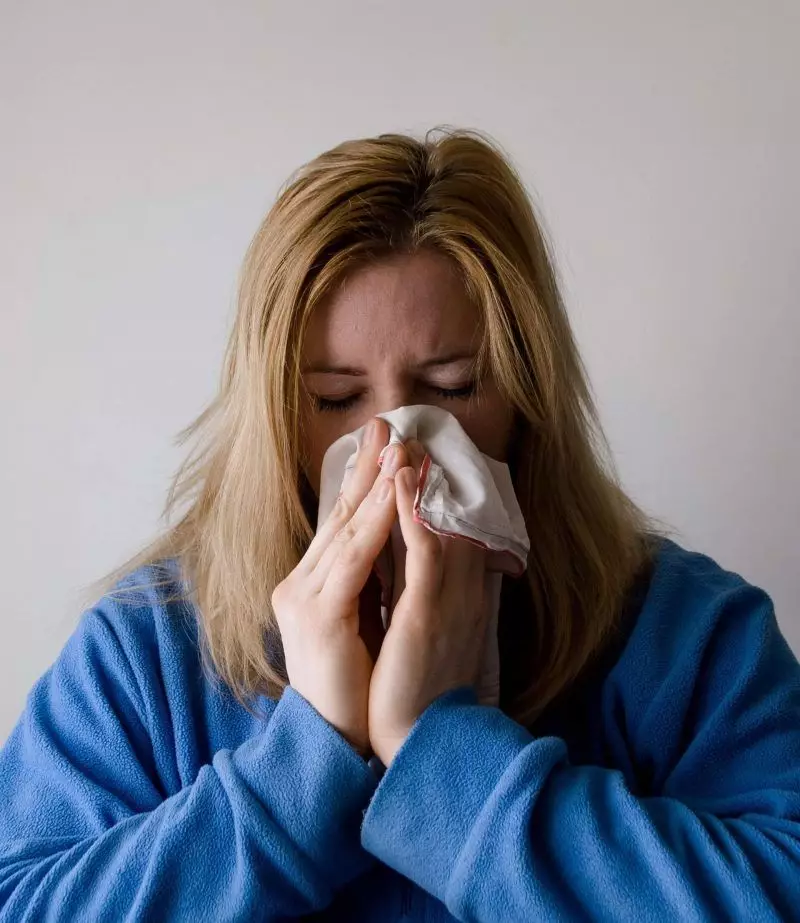
Skin allergies can be persistent and can significantly decrease your life quality (especially if they affect exposed skin areas).
There are 3 common types of skin allergies, which have similar symptoms, but can be caused by very different factors. These are Hives, Contact dermatitis, and Atopic dermatitis. [1]
Here, it’s important to mention that allergic reaction can be triggered either by a strong immune response to a certain allergen, or by a direct skin cells damage.
If you suffer from skin allergy, there are 3 important rules that you need to follow:
- Identify the cause for the allergy (allergen)
- Isolate yourself from the allergen
- Moisturize often
This article will reveal the common factors that cause skin allergy, and will guide you through the symptoms of these skin conditions.
Let’s get started!
That are the general symptoms of skin allergy?
The general symptoms of skin allergy include:
- Burning
- Itchiness
- Rash
- Redness
- Tiny bumps
- Swelling
- Cracking and flaky skin
The severity of those symptoms strongly depends on the affected skin area and the cause for this skin condition.

What causes skin allergies?
There are plenty of different factors, both internal and external, that can trigger allergic reaction. In this article we will focus on three main groups of allergens:
- Ingredients in cosmetic and personal care products
- External sources of free radicals
- Food allergens
What cosmetic ingredients cause allergic reactions?
There is an endless amount of allergens which are used as ingredients in household, personal care, and cosmetic products. The most common are:
- Alcohols
There are two different types of alcohols used in cosmetics: drying and moisturizing. Drying alcohols include isopropyl (ribbing alcohol), ethyl (also found as alcohol denat, denaturated alcohol, SD alcohol),and aromatic alcohols (e.g., benzyl alcohol), while the moisturizing ones are called fatty alcohols (e.g., cetyl, stearyl, cetearyl.)
Drying alcohols (including fragrance) are well known skin allergens and can cause eczema, irritation and excessive dryness when use dtopically. [2]
That being said, the vast majority of people are tolerant to fatty alcohols and don’t experience allergic reaction when they are exposed to this cosmetic substance. However, these alcohols are registered as allergens and can trigger eczema and irritation in individuals who are naturally predisposed to skin allergies. [3]
Formaldehyde is an invisible gas with a strong smell that is used as preservative in cosmetic products. When absorbed by the skin, this substance can cause irritation and allergic symptoms with different intensity depending on the volume of absorbed formaldehyde. [4]
Sulfates are used in cosmetic products as foaming agents. The most used sulphates and sodium lauryl sulfate (SLS) and sodium laureth sulfat (SLES). Even though these skincare ingredients are not registered as allergens or sensitizers, large number of people with sensitive skin develop contact dermatitis as a result of sulfate exposure. SLS and SLES can leave he skin itchy, cracked, and red. [5]

- Fragrances/perfumes
Fragrance can be listed as many different products in the ingredients list of your cosmetics: both alcohols and non-alcohols. Frequent exposure to fragrance can cause contact dermatitis to people with non-sensitive skin, while any exposure to fragrance may trigger allergic reaction in individuals with sensitive skin. [6]
- Natural rubber
Natural rubber, also called latex, is considered to be an allergen by the FDA. Exposure to latex may cause swelling, itching, and other allergy symptoms. About 1-6% of the general population is sensitive to natural rubber. [7]
Furthermore, natural rubber is not the only ingredient from natural origin that may cause allergic reaction. Essential oils and plant extracts are only some of the natural allergens that may negatively impact your skin.
- Preservatives
The use of cosmetics with preservatives like parabens, formaldehyde-releasing ingredients, and isothiazolinones (methylisothiazolinone) could trigger contact dermatitis reaction. Even though those substances protect your skincare products from contamination and bacterial growth, they can cause itching, swelling, redness, and other skin allergy symptoms. [7]
Phenoxyethanol is used as an alternative to the traditional preservatives mentioned in above. The concentration of this chemical in cosmetics is up to 1% as this is the maximum allowed (safe) concentration of phenoxyethanol.
However, as most people use various skincare products, their skin ends up absorbing more phenoxyethanol than the safe amounts. In that sense, this preservative can be related to diverse allergy symptoms, including eczema and itchiness. [8]

What free radicals cause skin allergy?
Free radicals are external and internal factors that affect the way our body and skin cells work. Those factors can be internal- byproducts of different chemical processes in the body; and external- UV light, pollution, radiation, smoking, and others. [9] They can reduce the regenerative function of the skin, make it more vulnerable and slow down the production of new and healthy skin cells. The free radicals that impact the skin include:
- Pollution
Evidence suggests that skin exposure to air polluting chemicals and substances may not only trigger allergic reaction like eczema and dermatitis, but also cause acne, psoriasis, and even skin cancer (long term direct exposure). [10]
- Smoking
A 2016 study published in the Journal of the American Academy of Dermatology suggests that smoking in general as well as passive exposure to cigarette smoke can cause predisposition to atopic dermatitis. [11] Besides, another study published in the Annals of Dermatology suggests that active hand dermatitis can be strongly associated with smoking habits. [12]
- Dust
Dust allergy is a popular one. The symptoms including itching and hives can be triggered not only by dust mites, but also by pollen, animal fur, and mould. Often this skin allergy is also related to other symptoms like runny nose, itchy and watery eyes, itchy throat. [13]

- Cancer treatment procedures
According to the American cancer Society, skin rash can occur as a side result of chemotherapy, radiation therapy, immunotherapy, targeted therapy, and stem cells transplant used as part of cancer treatment. The rash can appear of different skin areas and the severity of symptoms (painful and itchy skin, redness, swelling) can differ depending on the affected area and the longevity of treatment. [14]
- UV light
Patchy redness, itchy, painful and cracking skin, hives, and blisters are only some of the symptoms of sum allergy. It usually occurs short after the skin has been damaged by direct and unprotected exposure to sun rays. [15]
To prevent this type of skin allergy, generously apply and frequently reapply sunscreen with protection at least 30. Find out how to choose the sunscreen suitable for you in our dedicated article!

What foods can cause skin allergies?
Dietary food choices play a major role in managing the symptoms of skin allergies. That being said, touching or eating certain foods can cause allergic skin reaction and symptoms including rash, hives, itchiness, burning, swelling, and even painful skin areas. [16]
According to the CDC, about 90% of serious skin allergies may be caused by the intake of the following foods:
- Eggs
- Milk
- Fish and shellfish
- Wheat
- Soy
- Peanuts
- Tree nuts (e.g., walnuts, brazil nuts, almonds)
Besides, the consumption of those foods can also trouble and prolong the skin recovery from other allergic reactions (caused by free radicals, cosmetic ingredients, and other allergens). Furthermore, touching or having a direct skin contact with those foods can trigger eczema, rash, and irritation.
That being said, the NHS suggests that all kinds of foods may trigger allergic reaction. That, of course, depends on the allergic predisposition of the different individuals. [17] According to the source, other common allergens include:
- Gluten
- Celery
- Mustard
- Sesame seeds
- Pine nuts
- Meat
And according to DermNet NZ, other foods and plants that may cause allergic reaction include [18]:
- Seeds and nuts
- Fruits like figs, kiwi, chestnut, lemon, lime, and mango
- Corn
- Garlic, onion, leek
- Vegetables like artichoke, asparagus, lettuce, parsnip
- Legumes like chickpeas, peas, beans, lentils
- Herbs like mint, parsley and chives
Conclusion
The skin allergy causes can be difficult to detect and identify. Yet, limiting your exposure to these factors is the first step in the treatment of skin irritation.
If you are unsure what exactly causes your skin condition, consult your symptoms with a board-certified dermatologist. The doctor can conduct allergy tests, which to quickly identify the cause for the allergy. This way the dermatologist can prescribe timely treatment in the form of topical or oral medication to quickly improve your skin condition.
Learn how to improve the symptoms of skin allergy in our dermotologist-approved blog post!






